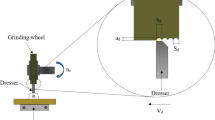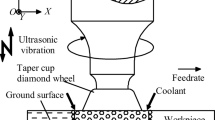Abstract
This paper investigates the machinability of Ti-6Al-4V in conventional surface grinding using silicon carbide abrasive which includes grinding force, specific grinding energy, surface topography, surface residual stress, and metallurgical structure alteration. The experimental result indicated that grinding force ratio and specific energy would decrease when chip formation played a dominant role in the mechanism of grinding. Workpiece ground surface was free of crack but cutting traces and micro-grooves on ground surface were much more obvious under higher feed rate. Chemical reactions and physical change existed in grinding of titanium alloys. Ground surface was in a state of high tensile residual stress under the effect of three mainly aspects: plastic deformation, microstructure transformation, and thermal cycling of surface layer which played the major role. The machined surface experienced microstructure alteration on the top layer of ground surface and a heat-affected zone was observed.
Similar content being viewed by others
References
Leyens C, Peters M (2003) Titanium and titanium alloys. Wiley–VCH GmbH & Co. KGaA, Weinheim
Ezugwu EO, Bonney J, Yamane Y (2003) An overview of the machinability of aeroengine alloys. J Mater Process Technol 134:233–253
Xu XP, Yu YQ, Huang H (2003) Mechanisms of abrasive wear in the grinding of titanium (TC4) and nickel (K417) alloys. Wear 68:1421–1426
Che-Haron CH, Jawaid A (2005) The effect of machining on surface integrity of titanium alloy Ti–6% Al–4% V. J Mater Process Technol 166:188–192
Editorial Board of China Aeronautical Materials Handbook (2002) China aeronautical materials handbook vol. 4 titanium alloy and copper alloy. Standards Press of China, Beijing
Wu CJ, Chen GL, Qiang WJ (2009) Metal material science. Metallurgical Industry Press, Beijing
Huang H, Liu YC (2003) Experimental investigations of machining characteristics and removal mechanisms of advanced ceramics in high speed deep grinding. Int J Mach Tools Manuf 43:811–823
Shaji S, Radhakrishnan V (2003) An investigation on solid lubricant moulded grinding wheels. Int J Mach Tools Manuf 43:965–972
Tawakoli T, Hadad MJ, Sadeghi MH, Daneshi A, Stöckert S, Rasifard A (2009) An experimental investigation of the effects of workpiece and grinding parameters on minimum quantity lubrication—MQL grinding. Int J Mach Tools Manuf 49:924–932
Syoji K, Guo YB, Wang ZZ (2007) Grinding process technology. China Machine Press, Beijing
Patnaik Durgumahanti US, Vijayender Singh, Venkateswara Rao P (2010) A new model for grinding force prediction and analysis. Int J Mach Tools Manuf 50:231–240
Sadeghi MH, Haddad MJ, Tawakoli T, Emami M (2009) Minimal quantity lubrication-MQL in grinding of Ti-6Al-4V titanium alloy. Int J Adv Manuf Technol 44:487–500
Salonitis K, Chondros T, Chryssolouris G (2008) Grinding wheel effect in the grind-hardening process. Int J Adv Manuf Technol 38:48–58
Tso P-L, Wu S-H (1999) Analysis of grinding quantities through chip sizes. J Mater Process Technol 95:1–7
Razavi HA, Kurfess TR, Danyluk S (2003) Force control grinding of gamma titanium aluminide. Int J Mach Tools Manuf 43:185–191
Bentley SA, Goh NP, Aspinwall DK (2001) Reciprocating surface grinding of a gamma titanium aluminide intermetallic alloy. J Mater Process Technol 118:22–28
Ren JX, Kang RK, Shi XK (1999) Grinding of difficult-to-cut materials. National Defense Industry Press, Beijing
Fathallah BB, Fredi NB, Sidhom H, Braham C, Ichida Y (2009) Effects of abrasive type cooling mode and peripheral grinding wheel speed on the AISI D2 steel ground surface integrity. Int J Mach Tools Manuf 49:261–272
Chen M, Li XT, Sun FH, Xiang YC, Xue BY (2001) Studies on the grinding characteristics of directionally solidified nickel-based superalloy. J Mater Process Technol 116:165–169
Soo SL, Hood R, Lannette M, Aspinwall DK, Voice WE (2010) Creep feed grinding of burn-resistant titanium (BuRTi) using superabrasive wheels. Int J Adv Manuf Technol 53(9–12):1019–1026
Author information
Authors and Affiliations
Corresponding author
Rights and permissions
About this article
Cite this article
Guo, G., Liu, Z., An, Q. et al. Experimental investigation on conventional grinding of Ti-6Al-4V using SiC abrasive. Int J Adv Manuf Technol 57, 135–142 (2011). https://doi.org/10.1007/s00170-011-3272-z
Received:
Accepted:
Published:
Issue Date:
DOI: https://doi.org/10.1007/s00170-011-3272-z




